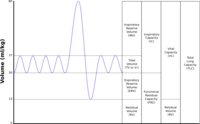
Low minute ventilation episodes during anesthesia recovery following intraperitoneal surgery as detected by a non-invasive respiratory volume monitor
Sign Up to like & getrecommendations! Published in 2017 at "Journal of Clinical Monitoring and Computing"
DOI: 10.1007/s10877-017-0093-0
Abstract: An electrical impedance-based noninvasive respiratory volume monitor (RVM) accurately reports minute volume, tidal volume and respiratory rate. Here we used the RVM to quantify the occurrence of and evaluate the ability of clinical factors to… read more here.
Keywords: respiratory; minute ventilation; minute; respiratory volume ... See more keywords

Variations in respiratory rate do not reflect changes in tidal volume or minute ventilation after major abdominal surgery
Sign Up to like & getrecommendations! Published in 2020 at "Journal of Clinical Monitoring and Computing"
DOI: 10.1007/s10877-020-00538-3
Abstract: Monitoring of postoperative pulmonary function usually includes respiratory rate and oxygen saturation measurements. We hypothesized that changes in postoperative respiratory rate do not correlate with changes in tidal volume or minute ventilation. In addition, we… read more here.
Keywords: tidal volume; respiratory rate; minute ventilation; rate ... See more keywords

Alveolar target ventilation and dead space in children under anaesthesia: The proventiped cohort study.
Sign Up to like & getrecommendations! Published in 2023 at "European journal of anaesthesiology"
DOI: 10.1097/eja.0000000000001832
Abstract: INTRODUCTION Ventilator settings in children under anaesthesia remain difficult because of the changes in the physiology and the high dead space. OBJECTIVE To determine the alveolar minute-volume to sustain normocapnia in children under mechanical ventilation.… read more here.
Keywords: dead space; group; ventilation; minute ventilation ... See more keywords

Reply: Carbon Dioxide Narcosis or Sleep Deprivation?
Sign Up to like & getrecommendations! Published in 2019 at "Annals of the American Thoracic Society"
DOI: 10.1513/annalsats.201903-204le
Abstract: We thank Drs. Aberegg and Carr for their interesting perspective on our patient (1).What they refer to as “assumptions,”we prefer to think of as clinical hypotheses, which are formed on the basis of the information… read more here.
Keywords: patient; paco2; sleep deprivation; risk ... See more keywords

Cardiorespiratory Responses to Voluntary Hyperventilation During Normobaric Hypoxia.
Sign Up to like & getrecommendations! Published in 2023 at "Aerospace medicine and human performance"
DOI: 10.3357/amhp.6163.2023
Abstract: BACKGROUND: Unexplained physiological events (PE), possibly related to hypoxia and hyperventilation, are a concern for some air forces. Physiological monitoring could aid research into PEs, with measurement of arterial oxygen saturation (Spo₂) often suggested despite… read more here.
Keywords: hyperventilation; voluntary hyperventilation; hypoxia; minute ventilation ... See more keywords